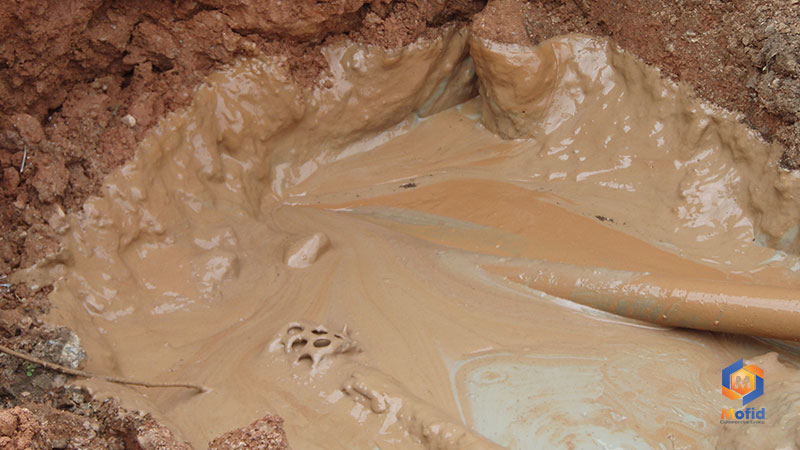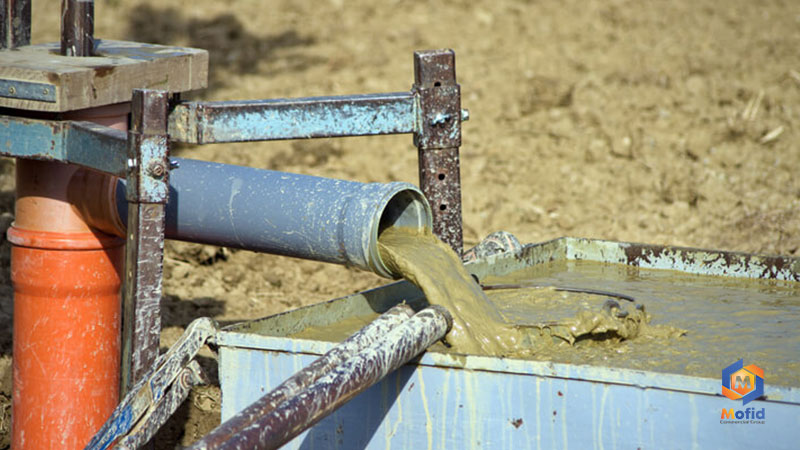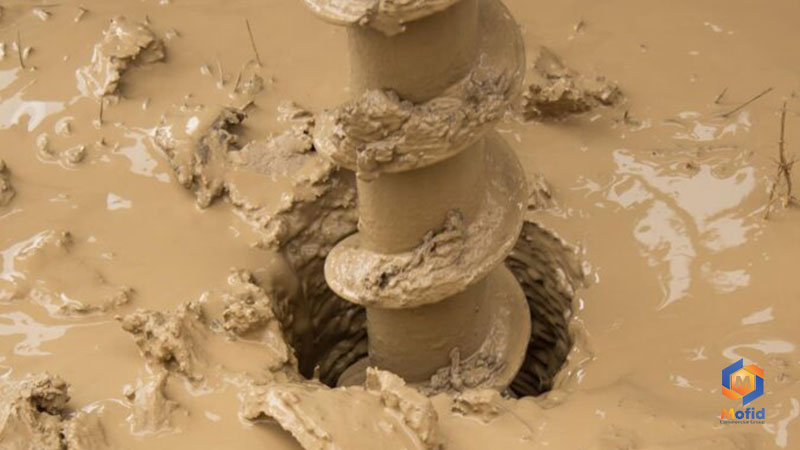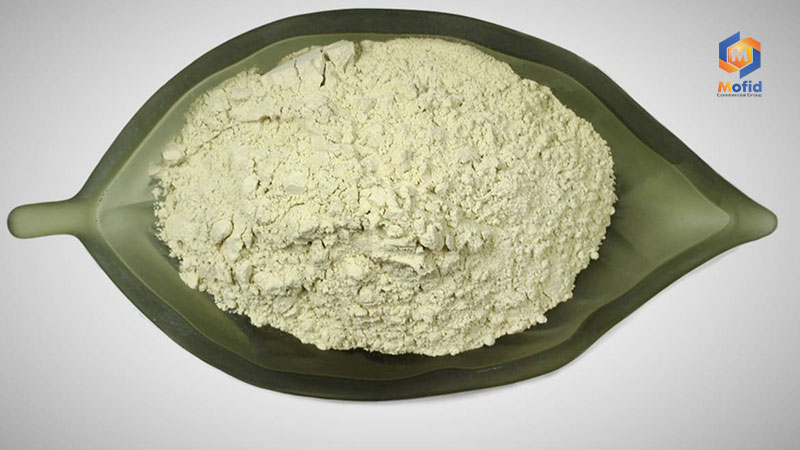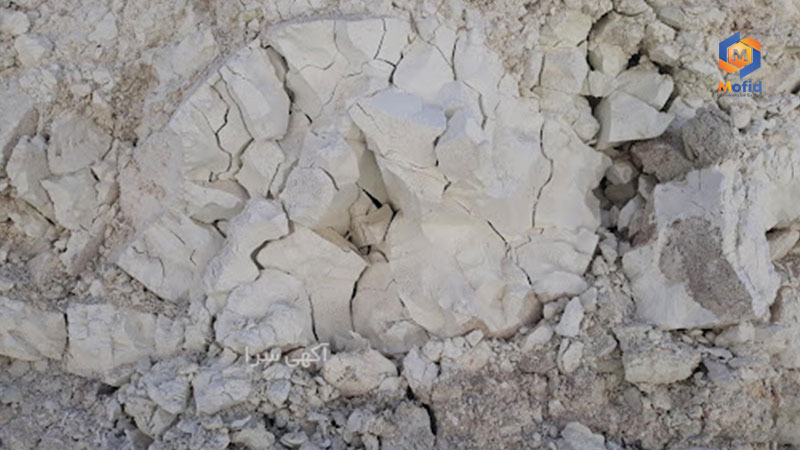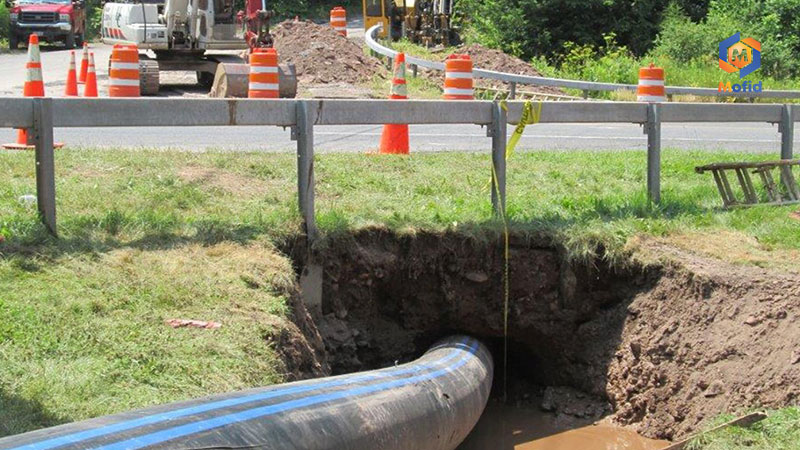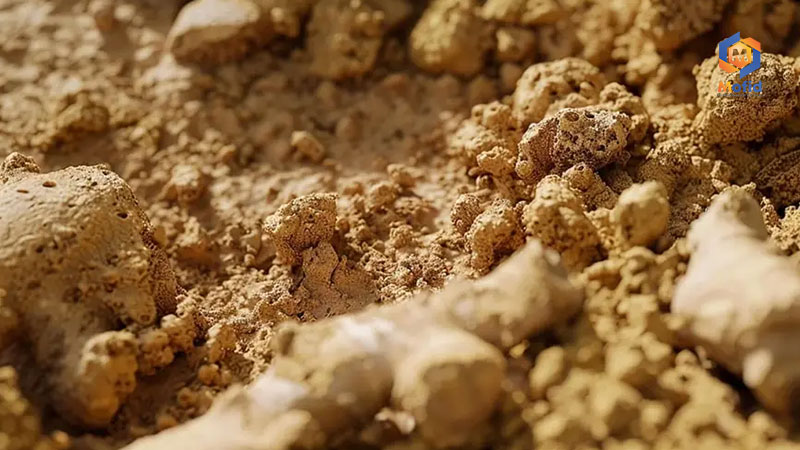Drilling Bentonite is a type of clay with high absorption properties, used in the oil and gas industries for lubrication, wall stabilization, and preventing drilling fluid leaks. This material plays an important role in improving performance and reducing costs by providing stability in drilling operations. In this comprehensive article, we will take an in-depth look at drilling bentonite, its applications, benefits, and important usage tips.
Bentonite, which is primarily made up of the mineral montmorillonite, is widely used in the drilling industry due to its unique properties such as high water absorption capacity and swelling ability. This material plays a fundamental role in the preparation of drilling mud, controlling well pressure, stabilizing well walls, and transporting cuttings to the surface.
By reading this article, you will gain a comprehensive understanding of the importance and role of drilling bentonite in the oil and gas industry. Whether you are an industry expert or a student or enthusiast in this field, this information can be valuable and useful to you.
Nature and Composition of Drilling Bentonite
Drilling Bentonite is a natural mineral bentonite primarily composed of the mineral montmorillonite. Due to its unique properties, it plays a crucial role in the oil and gas drilling industry. In this section, we will take a close look at the nature and composition of drilling bentonite.
Chemical Structure of Bentonite
Bentonite is chemically a hydrated aluminum silicate belonging to the smectite group. Its general chemical formula is as follows:
(Na,Ca)0.33(Al,Mg)2(Si4O10)(OH)2⋅nH2O
This layered structure allows bentonite to absorb water between its layers and swell, a feature that is vital in drilling operations.
Types of Bentonite Used in Drilling
Two main types of bentonite are used in the drilling industry:
- Sodium Bentonite: This type has a high swelling capacity and is suitable for making drilling mud with high viscosity.
- Calcium Bentonite: This type has less swelling capacity but is more resistant to ionic contamination.
Key Features of Drilling Bentonite
| Feature | Description | Importance in Drilling |
|---|---|---|
| Swelling Capacity | Absorbs water and increases in volume | Creates drilling mud with optimal viscosity |
| Cation Exchange Capacity | Ability to absorb and exchange ions | Controls the rheological properties of drilling mud |
| Plasticity | Ability to change shape without breaking | Forms a thin layer on well walls |
A deep understanding of the nature and composition of drilling bentonite is essential for its optimal use in drilling operations. This knowledge helps professionals select the best type of bentonite for the specific conditions of each project and maximize the performance of drilling mud.
Main Applications of Bentonite in Drilling Operations
Drilling Bentonite, due to its unique properties, has diverse and vital applications in oil and gas drilling operations. This natural mineral plays a key role in improving the efficiency, safety, and cost-effectiveness of drilling projects. Below, we explore the most important applications of bentonite in drilling operations.
- Formation of Drilling Mud
Bentonite is the main component in the preparation of water-based drilling mud. By absorbing water and swelling, it creates a colloidal suspension that has suitable rheological properties for drilling operations. Bentonite-containing drilling mud:
- Provides the right viscosity for carrying drill cuttings.
- Has thixotropic properties that help in maintaining well stability.
- Offers controlled filtration capability to prevent drilling fluid loss.
- Pressure Control and Well Stability
Bentonite in drilling mud helps control pressure and maintain well stability:
- Forms a mud cake on the wellbore walls to prevent caving and collapse.
- Adjusts the mud weight to control formation pressure and prevent blowouts.
- Reduces the permeability of well walls, preventing formation fluids from entering the well.
- Cooling and Lubrication of the Drill Bit
Bentonite-containing drilling mud plays a crucial role in cooling and lubricating the drill bit:
- Transfers heat from the drill bit and drill pipes to the surface.
- Reduces friction between the bit and rock, extending the bit’s lifespan and improving drilling speed.
- Prevents drill cuttings from sticking to the bit and pipes.
- Transportation of Drill Cuttings to the Surface
Bentonite in drilling mud helps efficiently transport drill cuttings to the surface:
- Provides sufficient viscosity to suspend cuttings in the mud.
- Prevents settling of cuttings in the well during the pause of mud circulation.
- Aids in effectively cleaning the well and improving drilling quality.
Deep Understanding of the Main Applications of Bentonite in Drilling Operations is Essential for Optimizing the Drilling Process.
Due to its multifaceted role in forming drilling mud, pressure control, well stabilization, cooling, and cuttings transport, bentonite significantly enhances the efficiency, safety, and cost-effectiveness of oil and gas drilling projects.
Benefits of Using Drilling Bentonite
As one of the most important materials in the oil and gas drilling industry, drilling bentonite brings several benefits to drilling operations. These benefits not only improve efficiency and safety but also have a significant impact on the economics of drilling projects. Below, we will explore the key benefits of using bentonite in drilling operations.
- Improved Wellbore Stability
Bentonite creates a thin, resistant layer (mud cake) on the wellbore walls:
- Prevents wall collapse and caving.
- Maintains hydrostatic pressure in the well.
- Prevents formation fluids from entering the well.
- Better Control of Drilling Mud Rheological Properties
Bentonite allows precise control over the properties of drilling mud:
- Creates the appropriate viscosity for transporting cuttings.
- Controls the yield point and gel strength of the mud.
- Enhances the thixotropic properties of the mud to prevent particle settlement during mud circulation pauses.
- Increased Drilling Efficiency
Using bentonite in drilling mud leads to more efficient operations:
- Improves cooling and lubrication of the drill bit, extending its life.
- Reduces friction between drilling pipes and wellbore walls.
- Facilitates the transport of drill cuttings to the surface and better well cleaning.
- Reduced Operational Costs
Bentonite contributes to cost reduction by improving drilling performance:
- Shortens drilling time by increasing bit penetration rate.
- Reduces drill bit and pipe consumption through enhanced lubrication.
- Minimizes costs associated with well issues such as pipe sticking and wall collapse.
- Environmental Compatibility
As a natural material, bentonite offers environmental benefits:
- It is biodegradable and does not cause long-term environmental pollution.
- It can be recycled and reused in some applications.
- Reduces the need for harmful chemical additives in drilling mud.
Key Benefits:
- Increased wellbore stability
- Better pressure control
- Enhanced drilling efficiency
- Reduced operational costs
- Environmental compatibility
Important Considerations:
- Need for precise property control
- Sensitivity to ionic contamination
- Limitations at very high temperatures
- Need for waste management
Using drilling bentonite brings significant advantages to oil and gas drilling operations. This material plays a vital role in improving wellbore stability, controlling drilling mud properties, enhancing operational efficiency, and reducing costs. However, to fully benefit from these advantages, a precise understanding of bentonite’s properties and proper management of its usage are essential.
Important Considerations in the Selection and Use of Drilling Bentonite
Proper selection and usage of drilling bentonite are crucial for the success of drilling operations. By following the tips below, you can ensure that you utilize this valuable material in the most effective way for your projects.
- Assessing the Quality of Bentonite
Before using bentonite, its quality should be evaluated:
- Check the amount of montmorillonite content (at least 70% for optimal quality).
- Measure the swelling capacity and water absorption.
- Evaluate the cation exchange capacity (CEC).
- Check for impurities and associated minerals.
- Choosing the Right Type of Bentonite
Choosing between sodium and calcium bentonite depends on drilling conditions:
| Bentonite Type | Characteristics | Suitable Applications |
|---|---|---|
| Sodium Bentonite | High swelling, high viscosity | Soft formations, need to control fluid loss |
| Calcium Bentonite | Lower swelling, resistant to ionic contamination | Hard formations, brackish water |
- Determining the Optimal Consumption Rate
The amount of bentonite should be adjusted based on drilling conditions:
- Conduct rheology tests to determine the optimal concentration.
- Consider well depth and formation pressure.
- Take into account the quality of water used in drilling mud preparation.
- Adjust the amount based on the formation type and drilling conditions.
- Proper Drilling Mud Preparation
To achieve the best performance, drilling mud should be prepared correctly:
- Use high-quality water (preferably fresh water).
- Gradually add bentonite to the water while continuously mixing.
- Allow sufficient hydration time (usually 24 to 48 hours).
- Control and adjust the pH of the mud (usually between 8.5 to 9.5).
- Managing and Controlling Drilling Mud Properties
During drilling operations, mud properties should be regularly monitored and adjusted:
- Regularly measure viscosity, mud weight, and rheological properties.
- Monitor filtration rate and mud cake thickness.
- Adjust mud properties by adding bentonite or other additives as needed.
- Pay attention to temperature and pressure changes with increasing depth and their impact on mud properties.
By following these guidelines, the effectiveness and performance of bentonite in drilling operations can be maximized, ensuring the success of the drilling process.
Warnings and Precautions
To ensure the effective and safe use of drilling bentonite, the following precautions should be observed:
- Avoid prolonged contact with dry bentonite powder (inhalation hazard).
- Ensure compatibility of any additives with bentonite before use.
- Consider the thermal limitations of bentonite (it performs poorly at very high temperatures).
- Proper management of drilling mud waste to minimize environmental impact.
Challenges and Limitations of Using Drilling Bentonite
Despite its numerous benefits, using drilling bentonite comes with challenges and limitations. Identifying these obstacles and finding solutions is essential for optimizing drilling operations. Below are the key challenges and practical solutions to overcome them:
- Thermal Limitations
Bentonite experiences structural changes at high temperatures (typically above 120°C), leading to reduced efficiency.Solution:- Use heat-resistant additives such as synthetic polymers.
- Use modified bentonites designed for high-temperature conditions.
- Carefully control and continuously adjust mud properties during drilling.
- Sensitivity to Ionic Contamination
The presence of multivalent ions (like calcium and magnesium) can significantly reduce bentonite’s swelling and viscosity.Solution:- Use additives like sodium carbonate to precipitate interfering ions.
- Opt for bentonites with enhanced resistance to ionic contamination.
- Continuously monitor the quality of water used for preparing the drilling mud.
- Issues with Inadequate Hydration
Incomplete hydration of bentonite can lead to poor drilling mud performance and operational problems.Solution:- Ensure sufficient hydration time (at least 24 hours).
- Use appropriate equipment for optimal mixing and hydration.
- Gradually add bentonite to water while constantly stirring.
- Challenges in Fluid Loss Control in Highly Permeable Formations
In highly porous formations, bentonite alone may not be sufficient to control fluid loss effectively.Solution:- Use additives like calcium carbonate or mica as fillers.
- Add fluid loss control polymers to bentonite mud.
- In critical cases, use cementing or injection of blocking agents.
- Environmental Issues and Waste Disposal
Improper disposal of drilling mud containing bentonite can lead to soil and water contamination.Solution:- Implement drilling mud recycling and treatment systems.
- Use environmentally safe disposal methods that comply with environmental standards.
- If possible, replace part of the bentonite with biodegradable materials.
| Challenge | Impact on Drilling Operations | Main Solution |
|---|---|---|
| Thermal Limitations | Reduced mud efficiency at high temps | Use heat-resistant additives |
| Ionic Contamination | Reduced swelling and viscosity | Use ion-precipitating additives |
| Inadequate Hydration | Poor mud performance | Ensure sufficient hydration time |
| Fluid Loss Control | Mud loss in highly permeable formations | Use fillers and fluid loss control polymers |
| Environmental Issues | Soil and water contamination | Recycling and safe disposal methods |
Despite the challenges associated with drilling bentonite, it remains a crucial component in drilling mud preparation. By understanding these challenges and implementing the appropriate solutions, the benefits of bentonite can be maximized while minimizing its limitations. Engineers and drilling experts should always aim to optimize the use of bentonite and seek innovative solutions to overcome the existing challenges.
Recent Innovations and Advancements in Drilling Bentonite
The drilling bentonite industry has witnessed significant advancements in recent years. These innovations have not only improved the efficiency of bentonite but have also opened new horizons in the oil and gas drilling industry. Below are the key innovations and their impact on the industry:
- Nanobentonites
The use of nanotechnology in the production and modification of bentonites is one of the most important recent advancements.Impact on Industry:- Significant increase in surface area and improved rheological properties.
- Reduction in the amount of bentonite required, enhancing drilling mud efficiency.
- Enhanced thermal and chemical resistance of drilling mud.
- Polymer-modified Bentonites
The combination of bentonite with specific polymers to improve performance under challenging drilling conditions.Impact on Industry:- Increased stability of drilling mud against ionic contamination and high temperatures.
- Improved control of fluid loss in highly permeable formations.
- Reduced friction and improved lubrication of drill bits and drilling pipes.
- Smart Bentonites
Development of bentonites that can respond to environmental changes.Impact on Industry:- Automatic adjustment of mud properties based on well conditions.
- Improved pressure control and well stability under variable conditions.
- Reduced need for continuous human intervention in adjusting mud properties.
- Environmentally Friendly Bentonites
Development of new formulations with an emphasis on environmental compatibility.Impact on Industry:- Reduced environmental impact of drilling operations.
- Facilitated disposal and recycling of drilling mud.
- Possibility of drilling in environmentally sensitive areas.
- Bentonite-Graphene Hybrid Systems
The use of graphene to improve the mechanical and thermal properties of bentonite.Impact on Industry:- Significant increase in thermal resistance of drilling mud.
- Improved thermal conductivity and cooling of the drill bit.
- Enhanced stability of mud under high pressure and temperature (HPHT) conditions.
| Innovation | Key Benefits | Challenges Ahead |
|---|---|---|
| Nanobentonites | Increased efficiency, reduced consumption | High production cost |
| Polymer-modified Bentonites | Stability in harsh conditions | Complexity of formulation |
| Smart Bentonites | Automatic adjustment of properties | Need for advanced technological development |
| Environmentally Friendly Bentonites | Reduced environmental impact | Maintaining efficiency at the level of conventional bentonites |
| Bentonite-Graphene Hybrid Systems | Excellent performance in HPHT conditions | High cost of graphene production |
Recent advancements in drilling bentonite herald a promising future for the oil and gas drilling industry. In the coming years, further development of smart and environmentally friendly bentonites is expected. Additionally, integrating cutting-edge technologies like artificial intelligence (AI) and the Internet of Things (IoT) with drilling mud systems could lead to the creation of advanced control systems and optimized drilling operations.
However, challenges such as high research and development costs and the need for specialized training of the workforce remain. Overcoming these challenges requires close collaboration between universities, research centers, and oil companies.
Comparison of Bentonite with Other Drilling Mud Additives
Bentonite is one of the most commonly used additives in drilling mud, but there are other alternatives that offer their own advantages and disadvantages. In this comprehensive comparison, we evaluate bentonite against other common additives in the drilling industry to provide a clearer understanding of which material might be the most suitable for different projects.
- Bentonite vs. Synthetic Polymers
Synthetic polymers such as polyacrylamide or xanthan gum are modern alternatives to bentonite.Advantages of Bentonite:- Lower cost
- Greater environmental compatibility
- Better performance in controlling filtrate loss
Disadvantages of Bentonite:
- More sensitive to ionic contamination
- Limited performance at high temperatures
- Requires larger volumes for optimal performance
- Bentonite vs. Barite
Barite is mainly used to increase the density of the drilling mud, whereas bentonite enhances its rheological properties.Advantages of Bentonite:- Improves rheological properties of the mud
- Better control of filtrate loss
- Forms a good filter cake
Disadvantages of Bentonite:
- Does not significantly increase the mud density
- Potential issues in shale formations
- Bentonite vs. Lignosulfonates
Lignosulfonates are used for viscosity control and reducing filtrate loss.Advantages of Bentonite:- Better performance in filter cake formation
- Better particle suspension
- Greater environmental compatibility
Disadvantages of Bentonite:
- Less control over viscosity at high temperatures
- Potential issues in water-sensitive formations
- Bentonite vs. Starch
Starch is used for controlling filtrate loss and improving rheological properties.Advantages of Bentonite:- More stable against bacterial degradation
- Better performance in filter cake formation
- Better particle suspension
Disadvantages of Bentonite:
- More sensitive to ionic contamination
- Weaker performance in controlling filtrate loss in highly permeable formations
| Additive | Main Use | Advantage over Bentonite | Disadvantage compared to Bentonite |
|---|---|---|---|
| Synthetic Polymers | Rheology control and filtrate loss | Better performance at high temperatures | Higher cost |
| Barite | Increase mud density | Ability to significantly increase mud weight | Does not improve rheological properties |
| Lignosulfonates | Viscosity control | Better performance at high temperatures | Weaker filter cake formation |
| Starch | Filtrate loss control | Better performance in highly permeable formations | Sensitive to bacterial degradation |
The comparison of bentonite with other drilling mud additives shows that each material has its own specific advantages and disadvantages. The choice of the best additive depends on several factors, including well conditions, formation type, environmental restrictions, and economic considerations.
Bentonite remains a fundamental additive in many drilling operations, but combining it with other additives can enhance the overall performance of drilling mud. Drilling professionals should carefully consider all aspects to select the optimal combination for each specific project.
With technological advancements, new and more advanced additives are expected to be developed, which may complement or even replace bentonite in certain applications. However, due to its economic and environmental benefits, bentonite is likely to continue playing an important role in the drilling industry.
Environmental Considerations in the Use of Drilling Bentonite
The use of bentonite in the oil and gas industry, while offering numerous technical benefits, can have significant environmental impacts. Understanding these impacts and adopting appropriate mitigation measures is essential not only for environmental conservation but also for the sustainability of drilling operations and enhancing the reputation of oil companies. In this article, we explore the key environmental considerations in the use of bentonite in drilling.
1. Water Pollution
Leaks of bentonite into surface and groundwater sources can result in water quality changes and damage to aquatic ecosystems.
Mitigation Measures:
- Use of closed-loop systems for drilling mud circulation
- Installation of protective layers around the drilling site
- Treatment and recycling of drilling mud before disposal
- Ongoing monitoring of surface and groundwater quality
2. Impact on Soil and Vegetation
Accumulation of bentonite on the surface can alter soil structure and harm vegetation cover.
Mitigation Measures:
- Careful management of drilling waste to prevent its spread in the environment
- Recycling and processing of used bentonite
- Implementation of vegetation restoration programs after drilling operations
- Use of biodegradable bentonites, where possible
3. Effects on Wildlife
Pollution from bentonite can negatively impact wildlife habitats and animal species.
Mitigation Measures:
- Conduct environmental impact assessments before starting drilling operations
- Create buffer zones between the drilling site and sensitive wildlife habitats
- Implement monitoring and protection programs for endangered species
- Educate staff on the importance of wildlife conservation
4. Resource and Energy Consumption
The extraction and processing of bentonite require natural resources and energy, which can have environmental impacts.
Mitigation Measures:
- Optimize the use of bentonite through precise drilling mud design
- Employ efficient technologies in the extraction and processing of bentonite
- Utilize renewable energy sources in the production process
- Develop and adopt eco-friendly alternatives to bentonite
| Environmental Impact | Impact Severity | Primary Mitigation Measure |
|---|---|---|
| Water Pollution | High | Closed-loop systems and treatment |
| Soil and Vegetation | Medium | Waste management and vegetation restoration |
| Wildlife Impact | Medium to High | Buffer zones and continuous monitoring |
| Resource and Energy Use | Medium | Optimization of consumption and use of renewable energy |
Best Practices for Reducing Environmental Impacts of Drilling Bentonite
- Implement an Environmental Management System (EMS) throughout all stages of drilling operations.
- Ongoing training for employees on environmental considerations and mitigation methods.
- Collaboration with environmental experts and NGOs to enhance environmental performance.
- Invest in research and development to find more eco-friendly alternatives.
- Transparency in environmental reporting and commitment to continuous improvement.
Although the use of drilling bentonite is essential for the oil and gas industry, it requires careful attention to environmental considerations. By adopting a comprehensive approach that includes prevention, mitigation, and remediation of negative impacts, a balance can be achieved between industrial needs and environmental protection.
Oil and gas companies should view these environmental considerations as an integral part of their operational strategies. This not only helps preserve the environment but can also improve efficiency, reduce costs, and enhance the company’s credibility.
With technological advancements and growing environmental awareness, we expect the development of more eco-friendly drilling methods and better alternatives to bentonite. Until then, the precise implementation of best practices and a commitment to continuous improvement will be key to achieving a balance between industrial development and environmental protection.
Factors Affecting Drilling Bentonite Price
- Purity and Quality of Bentonite The purity and overall quality of the bentonite directly affect its price. Higher-quality bentonite with better properties such as viscosity, swelling ratio, and lower moisture content tends to be more expensive.
- Order Volume and Purchase Quantity Larger orders often lead to reduced prices due to economies of scale. Bulk purchases are generally more cost-effective than smaller orders.
- Source Location and Transportation Costs The location of the supplier plays a crucial role in pricing due to transportation costs. Bentonite sourced from distant areas or with challenging logistics may incur higher transportation costs, influencing the final price.
- Market Fluctuations and Exchange Rates Price fluctuations in the market and changes in exchange rates can impact the cost of drilling bentonite, especially if it is sourced from international suppliers.
- Technical Features of the Product The technical properties, such as viscosity, swelling ability, and moisture content, affect the price. Bentonite with higher viscosity and better swelling properties is generally more expensive.
Important Tips for Purchasing Drilling Bentonite
- Always purchase from reputable sellers.
- Request the product’s analysis certificate to ensure its quality.
- Compare prices from several suppliers to get the best deal.
- Pay attention to the production date and storage conditions to ensure the product’s freshness and quality.
Frequently Asked Questions About Drilling Bentonite Pricing
Is the price of drilling bentonite fixed? No, the price of drilling bentonite is variable and depends on factors such as market conditions, exchange rates, and production costs.
Why is the price of different types of drilling bentonite different? Price differences arise due to variations in quality, purity, technical properties, and their intended applications. Higher-quality bentonites tend to cost more.
When is the best time to buy drilling bentonite? It is better to purchase during low-demand seasons when market fluctuations are minimal. Bulk purchases generally offer more favorable pricing.
Comprehensive Guide for Purchasing Drilling Bentonite
Drilling bentonite is available in various types and qualities. To make the right purchase, consider the technical specifications of the product, quality certifications, price, and the credibility of the supplier.
Standard Technical Specifications of Drilling Bentonite
| Specification | Standard Value | Importance |
|---|---|---|
| Moisture | Max 12% | Very Important |
| Viscosity | 30-40 centipoise | Very Important |
| Swelling Ratio | Min. 20 times | Important |
| pH | 8.5-9.5 | Medium |
Key Considerations Before Purchase
- Request a product analysis certificate.
- Check product samples before bulk purchase.
- Buy from licensed and reputable sellers.
- Check storage and transportation conditions.
- Compare prices from different sellers.
Steps for Purchasing Drilling Bentonite
- Determine the technical specifications required for your project.
- Request price quotes from reputable sellers.
- Review certifications and technical documents.
- Request samples for testing.
- Negotiate the price and delivery terms.
- Finalize the contract and make payment.
- Inspect the product upon delivery.
Types of Drilling Bentonite Packaging
- 25 kg bags (suitable for smaller purchases)
- 500 kg jumbo bags
- 1000 kg big bags (suitable for bulk purchases)
- Loose bulk (for large-scale projects)
Reliable Drilling Bentonite Suppliers
- Manufacturers with licenses from the Ministry of Industry
- Authorized distributors of reputable companies
- Specialty mineral supply stores
- Licensed trading companies
Frequently Asked Questions About Purchasing Drilling Bentonite
What is the minimum purchase quantity? Typically, the minimum purchase from a direct manufacturer is 1 ton. However, smaller purchases (e.g., 25 kg bags) are available through distributors.
What is the product warranty? Reputable sellers provide a quality certificate, ensuring the product meets the required standards. If the product does not meet technical specifications, returns are possible.
How long can drilling bentonite be stored? When stored under standard conditions (away from moisture and direct sunlight), bentonite can be kept for up to 2 years.

